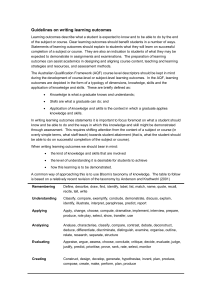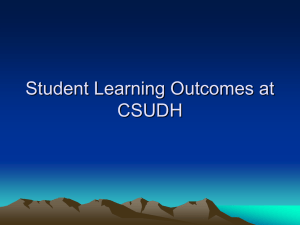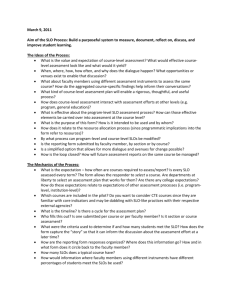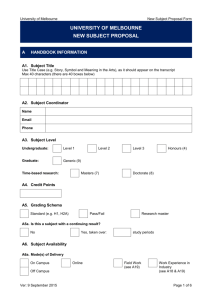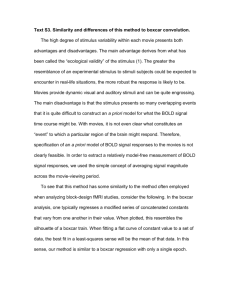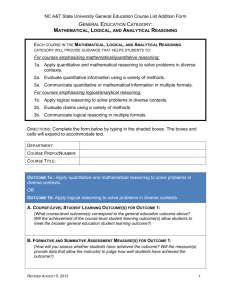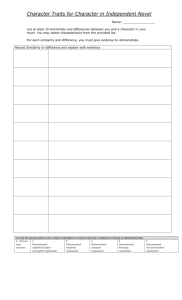Guidelines on writing learning outcomes
advertisement
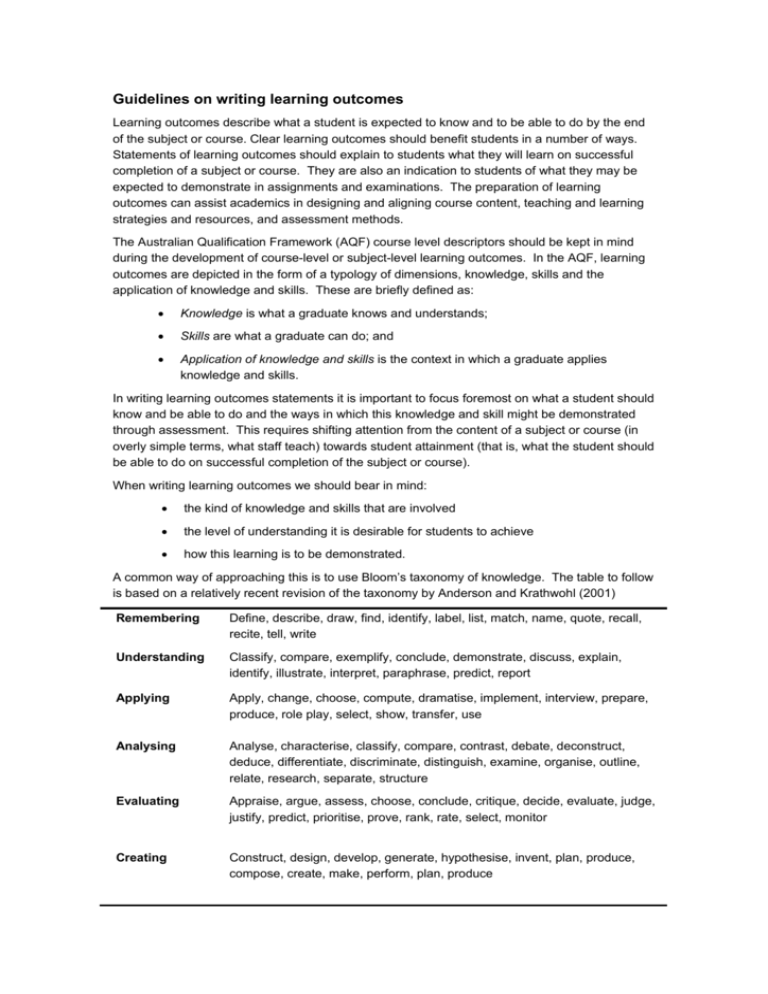
Guidelines on writing learning outcomes Learning outcomes describe what a student is expected to know and to be able to do by the end of the subject or course. Clear learning outcomes should benefit students in a number of ways. Statements of learning outcomes should explain to students what they will learn on successful completion of a subject or course. They are also an indication to students of what they may be expected to demonstrate in assignments and examinations. The preparation of learning outcomes can assist academics in designing and aligning course content, teaching and learning strategies and resources, and assessment methods. The Australian Qualification Framework (AQF) course level descriptors should be kept in mind during the development of course-level or subject-level learning outcomes. In the AQF, learning outcomes are depicted in the form of a typology of dimensions, knowledge, skills and the application of knowledge and skills. These are briefly defined as: • Knowledge is what a graduate knows and understands; • Skills are what a graduate can do; and • Application of knowledge and skills is the context in which a graduate applies knowledge and skills. In writing learning outcomes statements it is important to focus foremost on what a student should know and be able to do and the ways in which this knowledge and skill might be demonstrated through assessment. This requires shifting attention from the content of a subject or course (in overly simple terms, what staff teach) towards student attainment (that is, what the student should be able to do on successful completion of the subject or course). When writing learning outcomes we should bear in mind: • the kind of knowledge and skills that are involved • the level of understanding it is desirable for students to achieve • how this learning is to be demonstrated. A common way of approaching this is to use Bloom’s taxonomy of knowledge. The table to follow is based on a relatively recent revision of the taxonomy by Anderson and Krathwohl (2001) Remembering Define, describe, draw, find, identify, label, list, match, name, quote, recall, recite, tell, write Understanding Classify, compare, exemplify, conclude, demonstrate, discuss, explain, identify, illustrate, interpret, paraphrase, predict, report Applying Apply, change, choose, compute, dramatise, implement, interview, prepare, produce, role play, select, show, transfer, use Analysing Analyse, characterise, classify, compare, contrast, debate, deconstruct, deduce, differentiate, discriminate, distinguish, examine, organise, outline, relate, research, separate, structure Evaluating Appraise, argue, assess, choose, conclude, critique, decide, evaluate, judge, justify, predict, prioritise, prove, rank, rate, select, monitor Creating Construct, design, develop, generate, hypothesise, invent, plan, produce, compose, create, make, perform, plan, produce Phrasing learning outcomes in high general terms such as ‘remember’ or ‘understand’ is usually not helpful. It is best to aim for higher-level verbs which go beyond remembering or understanding, and which require analysis, evaluation or creation. It is good to consider phrases that describe how learning will be demonstrated (e.g. ‘communicate effectively and succinctly through oral presentation’, ‘apply theory critically to analyse a planning strategy’) Examples of subject-level learning outcomes from the University of Melbourne Handbook: On successful completion of this subject, students should be able to: • link structural design concepts and relate these to current construction practices; • interpret concrete structural drawings and be conversant with engineering terminology; • communicate construction solutions by means of sketches and drawings; • propose and evaluate alternate construction systems. On successful completion of this subject, students should be able to: • Explain the characteristics of successful businesses; • Identify the key activities and processes used by businesses to achieve their goals and objectives; • Make business decisions and identify the financial consequences that flow from those decisions; • Evaluate the financial performance of businesses; • Make and justify accounting policy decisions in accordance with generally accepted accounting principles. There are no fixed rules for the number of learning outcomes. It will depend on whether you are considering the outcomes for a course or a subject. On average, a subject typically has about four - six learning outcomes. Clearly, assessment tasks should be closely linked to subject and course learning outcomes. There are two levels that need to be considered in aligning assessment with learning outcomes within the AQF: 1. Explicitly linking subject-level outcomes to course-level outcomes 2. Ensuring that subject assessment tasks are designed so that students demonstrate the subject-level learning outcomes The following table offers advice on matching assessment to subject-level and course-level learning outcomes. It has been adapted from the Guide for reviewing assessment, available at http://www.cshe.unimelb.edu.au/resources_teach/assessment/docs/GRA.pdf In what ways is it ensured that assessment is matched to subject and course learning outcomes, including generic skills? Questions For example: • Are the relationships between subject learning outcomes, teaching and learning activities, and assessment tasks made explicit? • Taken together, does the suite of assessment tasks that a student experiences over the course of their studies align with the learning outcomes specified for that course? Critical analysis & oral communication Subject-level learning outcomes include: “Students will be able to critically analyse scientific research papers”; and “Students will be able to communicate effectively and succinctly through oral presentation” Learning: Student groups are assigned a scientific paper to review and describe as an oral presentation (several weeks later). One lecture is devoted to modelling the process of analysing a scientific paper. Students are encouraged to practise their talks and provide feedback within their group (peer review). Examples Assessment: Students are assessed, individually, on the part of the paper that they each analysed and presented. 70% of the mark is for demonstrated understanding and explanation, 30% for the technical quality of the presentation. The connections between the learning outcomes, teaching and learning process and assessment of the group assignment are made explicit to students early in semester, both in class and via the subject website (but are not detailed in the Handbook entry). Course mapping of subject-level to course-level learning outcomes Each subject: 1. Subject-level learning outcomes are mapped onto the course-level outcomes 2. This information is used to produce a ‘course map’, showing the learning outcome combinations across the subject-levels of the course; 3. Learning and assessment tasks for these subjects are plotted onto the course map. Course mapping is used to identify gaps or redundancies in the development and assessment of the course-level learning outcomes, and to check that the tasks (both learning and assessment) increase in complexity* across the year levels, and are linked to higher level verbs from Bloom’s revised taxonomy. *see also Guide for reviewing assessment, pp. 8-9 Learning outcomes often tend to establish threshold levels of attainment for passing a subject. Grading criteria can assist in indicating what a student needs to demonstrate to achieve a higher grade. The criteria sheets will have a set of statements that point to the different levels of a students’ performance from H1 to Unsatisfactory. Rather than focusing on the threshold levels of attainment stated in the learning outcomes, students can also see the criteria for demonstrating higher-level learning. Although learning outcomes are a useful articulation of our intent as educators, they should not drive the entire educational agenda. Good teaching and learning often occurs informally and unplanned through the interaction of teachers and their students. Learning will and should occur that has not been documented in course and subject learning outcomes.
